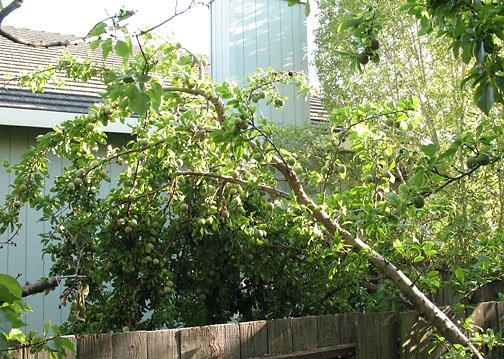Should I Stake My Fruit Tree

Often times when you buy a young fruit tree from a nursery it comes in a pot and the trunk is secured to a stake. If the trunk isn’t large enough, the tree will often lean or flop over once that stake is removed. Proper staking can help aid the tree as it gets established in its forever home.
Is it necessary to stake a tree? The answer is not always. If a tree is able to stand upright after planting, then staking isn’t needed. In fact it can have some adverse effects when a tree is unnecessarily staked. It can be helpful to still stake a young tree if you’re in an area prone to extreme winds, but otherwise some wind can actually benefit a tree with growing a stronger root system.
Will staking a tree adversely affect it?
Staking a tree can cause problems for a fruit tree. As the tree sways it signals to the trees roots to grow further out and for the base to flare more to add strength. If the tree is fully secured and not allowed to sway at all, this inhibits this base growth. If the tree has a weak base then the tree won’t be as strong. Another factor that goes into staking is the material wrapped around the trunk. Depending on what you use, it can cause burn or cut into the trunk exposing the tree to disease.

What can I use for tree stakes?
When identifying stakes for your trees you want something that is going to be durable. Using things like wood or metal works well. I like stakes that are at least a couple feet high for strength, some tree staking kits can be hammered directly into the ground like staking a tent.
How do you stake a newly planted tree?
After the fruit tree has been planted, generally a berm is created around the tree. A berm is simply a ring around the base of the tree where the hole was dig. Typically soil is mounded around the edge of the berm to retain moisture. You may find my post, How to Improve Clay Soils for Fruit Trees, helpful. I recommend installing your stakes just outside the berm. Since the berm will be watered and kept moist, it’ll soften the soil causing the sticks to shift more easily. It’s a good idea to use three to four stakes around the tree about equal distance apart.
Using things like wire or rope to wrap around the trunk of the tree can damage the trunk. Try something that is made of rubber or fabric for tree wraps. An old hose works well or you could try these: Villa Tree Ties 10 Pack. Remember to allow some room for the trunk to be able to slightly sway and not so tight that the tree won’t move at all. This is the set-up that I recommend: EasyPost Tree Stake Kit Include Tree Tie Garden Tree.

How long should you stake a tree?
A good rule of thumb for staking fruit trees is to keep the tree staked for one growing season. You want to stake a tree for the minimum amount of time possible just as a means to help the tree get established. Typically after one growing season the tree should be strong enough to make it without staking. After that initial time period, the stakes and all straps should be completely removed.
Is a leaning tree dangerous?

A tree may be leaning for various reasons. It could have been due to settling after planting or planting it at a slight lean. Sometimes the environment plays a part in creating the lean if the tree is competing for sunlight or effected by strong winds over time. A leaning tree can be dangerous when it is close to a house or structure that may be effected if it were to come down. Another possible dangerous scenario would be if kids were playing around the tree or if it was leaning over a walkway. A lot depends on how much of a lean is happening with the tree. Major causes for concern would include:
- When tree starts leaning unexpectedly
- Roots begin to become exposed on opposite side of lean
- Major change to the lean
- A storm causes a noticeable change in the lean
- The lean could pose a safety threat to people or structures around it
Will a tree straighten itself?
No, Once a tree is leaning or growing crooked it will continue to grow that way. It will take manual corrective measures to aid the tree in growing straight. It’s best to help the tree grow straight when young. When a tree is younger it’s more pliable and easier to correct.
How do you straighten a crooked tree trunk?
Again, this will be most effective with a younger tree that is more workable. Once a tree has a grown with a crooked trunk for several years it will continue to grow that way. For young trees with a crooked tree, stake the tree as previously discussed, but instead of allowing it to remain looser, tighten each line to until the trunk has straightened out. Leave the tree staked in this manner until it will remain straight on its own.
Final Thoughts
Ideally a newly planted tree will be strong enough to hold up on its own, but when that’s not the case, staking can aid the tree for the short term. Even though staking a tree can potentially have some adverse effects, it’s better than having the tree uprooted or snapped in half.
Please comment below on anything that you’ve enjoyed from this post.
